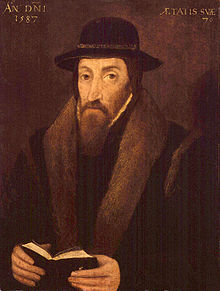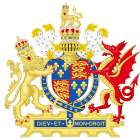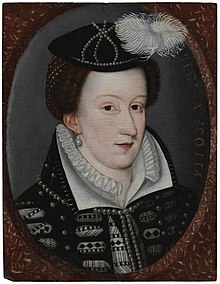Thomas Howard, 4th Duke of Norfolk
Roman Catholicism | |
|---|---|
Thomas Howard, 4th Duke of Norfolk,
Norfolk was the son of the poet, soldier and politician Henry Howard, Earl of Surrey. He was executed for his role in the Ridolfi plot.
Early life, family, and religion

Thomas was born on 10 March 1536 (although some sources cite his birth in 1538)
Thomas' father, the Earl of Surrey, a Catholic but with reformist leanings, was heir to the 3rd Duke, and thereby destined to become the future 4th Duke; but that changed at the end of 1546 when Surrey
Initially Surrey and his wife, Lady Frances, entrusted the education of their children to the Dutch physician and classical scholar
Career

| Duke of Norfolk's Restitution Act 1553 | |
|---|---|
| Act of Parliament | |
 38 Hen. 8 . c. 1 |
Because his father had died before his grandfather, Thomas was now in line to become 4th Duke of Norfolk. In December 1553 he received the courtesy title of
After his grandfather's death in August 1554, Thomas succeeded him as 4th Duke and hereditary Earl Marshal of England. Howard had been preparing over the previous months to gradually take charge of the vast family inheritance received, although as Thomas was still a minor at the time of his grandfather's death, guardianship of the new Duke was left in the hands of Queen Mary.[10] Despite this, Howard was able to make some decisions such as organising his grandfather's funeral and burial in St Michael the Archangel's Church, Framlingham, and making the necessary arrangements for the guardianship of his sisters. Bassingbourne Gawdy, one of the lawyers in charge of the succession to Howard's estates, rode post haste to London with letters for Lord Chancellor Gardiner and returned as speedily as he could to Norwich. The escheator of Norfolk held a formal inquisition to survey the great Howard inheritance, of fifty-six manors, and 'many other considerable estates', which passed for the present into the hands of the Crown, until Thomas came of age. His younger siblings would also receive 1,000 marks each on coming of age, or marriage, according to the terms of their grandfather's will.[10] Once he came of age in March 1557, Howard was able to administer all his estates, becoming one of the richest landowners in England.
In September 1554, Thomas arranged for the marriage of his sister Katherine to Henry Berkeley, 7th Baron Berkeley; this took place at Howard's mansion at Kenninghall.[10]
Queen Mary died in November 1558 and was succeeded by her Protestant half-sister Elizabeth I. Howard was a second cousin of Elizabeth through her maternal grandmother, Lady Elizabeth Howard, sister of the 3rd Duke and mother of Anne Boleyn, and he was trusted with public office despite his family history and being Catholic.
As Earl Marshal, Howard was in charge of organising Elizabeth's coronation on 15 January 1559 and the celebrations afterwards. Shortly after ascending the throne, the Queen made Norfolk a
Mary, Queen of Scots, and the Rising of the North

Norfolk was the principal commissioner at the conference held in
Having recently lost his third wife, and despite having presided over the York commission, Norfolk began planning his marriage to Mary. For both parties, it would have been their fourth marriage; Howard had been widowed three times, whilst Mary had been widowed twice and her third husband, James Hepburn, 4th Earl of Bothwell, had escaped but ended up as a prisoner in Denmark. Both Howard and Mary were descended from the House of Plantagenet. Furthermore, the former Scottish monarch had a strong claim to the English crown as a descendant of Henry VII, the first monarch of the reigning Tudor dynasty, through her paternal grandmother Margaret Tudor and already considered herself the rightful Queen of England, on the grounds that Elizabeth had been declared illegitimate following the annulment of the marriage of her parents, Henry VIII and Anne Boleyn in 1536. As the English monarch had no direct heirs, having never married, the claim to the throne of Catholic Mary Queen of Scots represented a serious threat to the Protestant religious policies enacted after Elizabeth's accession in 1558. Both the Scottish statesman William Maitland of Lethington and the Bishop of Ross, John Lesley, Mary's chief adviser and agent, were in favour of the Duke's marriage to the former Scottish queen, and Mary herself consented to it, although Howard was initially reluctant to bring about political and religious change. Initially Howard showed little sympathy for Mary, but during recesses from the conference in York, Maitland met privately with Norfolk, suggesting to the Duke the possibility of marrying Mary, as well as a possible future marriage between Howard's daughter, Margaret and the infant King James VI.[15] Norfolk saw in this proposal not only the means to solve the succession crisis which had plagued England ever since Elizabeth's accession, given her reluctance to marry and produce an heir, but also an opportunity for his own social aggrandisement. Furthermore, Mary's marriage to the leading English nobleman would help the former Scottish monarch to strengthen her claim to the throne.
Initially, the relationship between Norfolk and the former Scottish sovereign was platonic and they communicated through letters. Mary sent Norfolk a gift of a pillow embroidered with the Stewart family motto Virescit vulnere virtus (courage grows strong at a wound) and her coat of arms. The Duke, through Lord Boyd, a member of Mary's private circle, sent a diamond to be delivered to her as a token of his affection and fidelity. Mary, grateful for the gift, wrote to Norfolk in December 1569 that she "I took the diamant from my lord Boyd, which I shall kepe unseene about my neck till I give it agayn to the owner of it and me both.".[16]
A marriage to Mary would have given the Duke a political advantage at court, as he was by now a rival of Elizabeth's favourite, Dudley, and an enemy of Cecil. The marriage scheme was supported by most of the Catholic nobility, and some assumed that the Duke was willing to lead a revolt against Elizabeth.[17] In November 1569 the Rising of the North broke out, organised by Charles Neville, 6th Earl of Westmorland, brother-in-law and also second cousin of Norfolk, and Thomas Percy, 7th Earl of Northumberland. Howard briefly participated in the revolt, hoping that if he succeeded, he would achieve the release of Mary, who was then being held in Tutbury Castle. It is still debated whether the rebellion actually aimed to overthrow Elizabeth, and whether Mary even knew about it beforehand. After initial successes, Westmorland and Northumberland retreated northward and finally dispersed their forces, fleeing into Scotland when Elizabeth sent an army under Thomas Radclyffe, 3rd Earl of Sussex, to quell the rebellion. Norfolk tried to stop the revolt when he saw that it was going to fail, but Elizabeth ordered his arrest after receiving news that the rising had taken place.
Norfolk was a prisoner in the Tower of London until August 1570 when he was released for lack of evidence, and also because he confessed his intentions and begged the Queen for mercy. Thomas' intention to marry Mary, although objectionable to Elizabeth, was not a sufficient reason to charge him with treason, and also at that time there was insufficient evidence against Howard since he was not directly involved in the revolt in the north.[9]
Involvement in the Ridolfi plot and execution
Shortly after Howard was released
Laurence Bannister testified on favour of Norfolk, clarifying that the Duke's brother, Henry, was the one who really intended to marry the former Scottish queen.[19]
Norfolk initially denied all charges against him, but later admitted a degree of involvement in the transmission of money and correspondence to Mary's Scottish supporters and her participation in the Ridolfi plot.[20] The evidence to prosecute Norfolk was now much stronger than in 1569–70, as it was clear that he had been involved in a conspiracy with support from the Papacy, Spain and possibly France, to overthrow and assassinate Elizabeth. At his trial on 16 January 1572, which lasted twelve hours, Norfolk pleaded his innocence. However, the jury of peers unanimously found him guilty of high treason, and he was sentenced to death.
After Norfolk had been sentenced, it was reasonable to suppose that his execution would quickly follow. It was rumoured that he was to be executed on 31 January, whereupon crowds flocked to the Tower. Elizabeth, torn between the demands of justice on the one hand and Norfolk's 'nearness of blood [and] ... his superiority of honour' on the other, did not sign the warrant until 9 February, and on the next day she countermanded her instructions. She did the same thing a fortnight later, to the dismay of Cecil (now ennobled as Lord Burghley) and the Privy Council. They insisted that Parliament be assembled to debate the threat posed by Norfolk and Mary, although Elizabethan parliaments normally met only every three or four years and the previous parliament had been dissolved only ten months earlier.
The new parliament, the fourth of Elizabeth's reign, assembled on 8 May 1572. Over the course of the next three weeks Burghley and the Council used their spokesmen in the House of Commons to press the case for executing Norfolk. On 21 May, Leicester remarked that he could 'see no likelihood' that Norfolk would be executed. In late May, two Council members went so far as to observe that by failing to execute the Duke, the queen was demonstrating that she believed the guilty verdict to be incorrect, which 'dishonoureth the nobles that have condemned him'. The Queen continued to resist re-signing the order, until her opinion suddenly changed when she encountered strong parliamentary pressure calling for the executions of both Norfolk and Mary. As Stephen Alford has observed, Norfolk's execution 'was the political price Elizabeth had to pay to save the Scottish Queen'. Even so, Elizabeth was determined that the decision to execute the Duke should be seen to be hers rather than Parliament's. On Saturday, 31 May, the Crown's spokesmen in the Commons persuaded the lower house, with great difficulty, to postpone petitioning the Queen to execute the Duke until the following Monday (2 June), 'in hope to hear news before that time'. The hint was well taken, as Norfolk finally went to the block less than one hour before the Commons reassembled.
During his last days, Howard was visited by his former tutor Foxe, who gave him for the purpose of consolation a version in Latin of his Book of Martyrs. Norfolk bequeathed to Foxe an annuity of £20 per year.[10] The Duke also wrote to his mother's second husband, Thomas Steyning, asking that she be sent to the quiet of the countryside. Norfolk feared that if his mother was in London on the day of his execution, she might suffer health problems from shock.[10]
At sunrise on 2 June 1572, Norfolk was led to a specially erected scaffold on
and then, before a silent crowd, which had been urged not to shout out to avoid 'frighting' his soul, the Duke's head was severed with a single stroke. Howard was between aged 34 or 36 at the time of his death.Norfolk was the first nobleman to be executed during Elizabeth's reign, and was the first since
Norfolk's lands and titles were forfeit, although much of his estate was later restored to his sons. The dukedom was restored, four generations later, to his great-great-grandson Thomas Howard.
Mary narrowly escaped execution on that occasion, but after being implicated in several subsequent Catholic plots, she finally fell from grace and was executed in February 1587.
Marriages and issue
First wife

In March 1555, the Duke, then aged between 16 or 19, married his first wife, Lady
- Philip Howard, Earl of Surrey (by courtesy) from 1557 to 1572. Following the death of his mother and years later his maternal aunt, Jane, Philip became sole heir to the Arundel earldom and all the FitzAlan family estates. After the death of his maternal grandfather in 1580, Philip became the 13th Earl of Arundel. For remaining loyal to Catholicism, he was imprisoned in the Tower of London in April 1585, remaining there until his death from natural causes in October 1595. Shortly after his death he was declared a Catholic martyr, and he was canonised in 1970 as one of the so-called Forty Martyrs of England and Wales. His tomb and shrine are in Arundel Cathedral.
It is from this marriage that Howard's descendants, the modern dukes of Norfolk, derive their surname of 'FitzAlan-Howard' and their seat in Arundel.
The Duchess suffered serious health complications after the birth of Philip, possibly due to
Second wife


In early 1558, Norfolk became betrothed to
Norfolk's children by his marriage to Margaret were:
- Lady Elizabeth Howard (1560–?), who died in early childhood. She was buried in St Michael the Archangel's Church, Framlingham.
- Katherine Knyvetc. 1583 and had issue.
- Lady Margaret Howard (1562–1591), who married Robert Sackville, 2nd Earl of Dorset, and had issue.
- Lord William Howard of Naworth Castle and Henderskelfe Castle (now the site of Castle Howard) (1563–1640), who married his step-sister Elizabeth Dacre and had issue. The Earls of Carlisle are direct descendants of Lord William.
At Christmas 1563, Margaret, anxious to be reunited with her husband, left Audley End, despite being still weak from the birth of her fourth child a few days before. During the journey she fell ill with a respiratory condition that worsened as the days passed, and she died in
Third wife

Shortly after Margaret's death, Norfolk married
Norfolk's three sons by his first two wives, Philip, Thomas and William, married, respectively, Anne, Margaret, and Elizabeth Dacre. The Dacre sisters were the daughters of Elizabeth Leyburne by her marriage to Thomas Dacre and were therefore stepsisters to Norfolk's sons.
Elizabeth died in September 1567, shortly after giving birth to a baby, whose sex is not known and who also died. She was buried at St. Mary's Church, Kenninghall.
Depictions
- Thomas Howard appears as a character in the Philippa Gregory novels The Virgin's Lover and The Other Queen, and in the novel I, Elizabeth by Rosalind Miles.
- A highly fictionalised version of the Duke, played by Christopher Eccleston, is in the 1998 film Elizabeth.
- Another version of the Duke is in the BBC mini-series The Virgin Queen, played by Kevin McKidd.
- In the documentary Elizabeth (2000) presented by David Starkey, the Duke is portrayed by actor John Gully.
Family tree
Through his maternal and paternal lineages, Howard was related to the most important families of the English and Welsh nobility. Through his ancestor
| Ancestors of Thomas Howard, 4th Duke of Norfolk | ||||||||||||||||||||||||||||||||||||||||||||||||||||||||||||||||||||||||||||||||||||||||||||||||||||||||||||||||||||||||||||||||||||||||||||||||||||||||||||||||||||||||||||||||||||||||||||||||||||||||||||||||||||||||||||||||||||||||||||||||||||||||||||||||||||||||||||||||||||||||||||||||||||||||||||||||||||||||||||||||||||||||||||||||||||
|---|---|---|---|---|---|---|---|---|---|---|---|---|---|---|---|---|---|---|---|---|---|---|---|---|---|---|---|---|---|---|---|---|---|---|---|---|---|---|---|---|---|---|---|---|---|---|---|---|---|---|---|---|---|---|---|---|---|---|---|---|---|---|---|---|---|---|---|---|---|---|---|---|---|---|---|---|---|---|---|---|---|---|---|---|---|---|---|---|---|---|---|---|---|---|---|---|---|---|---|---|---|---|---|---|---|---|---|---|---|---|---|---|---|---|---|---|---|---|---|---|---|---|---|---|---|---|---|---|---|---|---|---|---|---|---|---|---|---|---|---|---|---|---|---|---|---|---|---|---|---|---|---|---|---|---|---|---|---|---|---|---|---|---|---|---|---|---|---|---|---|---|---|---|---|---|---|---|---|---|---|---|---|---|---|---|---|---|---|---|---|---|---|---|---|---|---|---|---|---|---|---|---|---|---|---|---|---|---|---|---|---|---|---|---|---|---|---|---|---|---|---|---|---|---|---|---|---|---|---|---|---|---|---|---|---|---|---|---|---|---|---|---|---|---|---|---|---|---|---|---|---|---|---|---|---|---|---|---|---|---|---|---|---|---|---|---|---|---|---|---|---|---|---|---|---|---|---|---|---|---|---|---|---|---|---|---|---|---|---|---|---|---|---|---|---|---|---|---|---|---|---|---|---|---|---|---|---|---|---|---|---|---|---|---|---|---|---|---|---|---|---|---|---|---|---|---|---|---|---|---|---|---|---|---|---|---|---|---|---|---|
| ||||||||||||||||||||||||||||||||||||||||||||||||||||||||||||||||||||||||||||||||||||||||||||||||||||||||||||||||||||||||||||||||||||||||||||||||||||||||||||||||||||||||||||||||||||||||||||||||||||||||||||||||||||||||||||||||||||||||||||||||||||||||||||||||||||||||||||||||||||||||||||||||||||||||||||||||||||||||||||||||||||||||||||||||||||
References
- ISBN 978-0199550371
- ^ Williams, Neville (1964). A Tudor Tragedy:Thomas Howard Fourth Duke of Norfolk. pp. 1, 262. In the 19th century Howard was incorrectly thought to be born in 1536.
- ISBN 978-0-19-818625-0.
- ^ The Heraldic Charge Against the Earl of Surrey, Peter R. Moore, English Historical Review, Vol. CXVI, pp. 557–583, (2001).
- ISBN 978-0199550371
- ^ doi:10.1093/ref:odnb/13941. (Subscription or UK public library membershiprequired.)
- ^ Adams, H.G. A cyclopedia of female biography.
- ^ Kenny 1970, pp. 9–10.
- ^ a b c d Chisholm, Hugh, ed. (1911). . Encyclopædia Britannica. Vol. 19 (11th ed.). Cambridge University Press. p. 744.
- ^ a b c d e f g h i j k l Graves 2008.
- doi:10.1093/ref:odnb/30112. (Subscription or UK public library membershiprequired.)
- ^ "Thomas Howard 4th Duke of Norfolk" Spartacus Educational
- ^ Calendar of State Papers Scotland, vol. 1 (1898), 323, 440.
- ^ HMC: Manuscripts of the Earl of Salisbury at Hatfield, vol.1 (1883), p. 461.
- ^ "Thomas Howard, 4th Duke of Norfolk".
- ^ Labanoff, vol. 3, p. 5: James Balfour Paul, Scots Peerage, vol. 5 (Edinburgh, 1908), p. 156
- ^ a b "The execution of Thomas Howard, 4th duke of Norfolk" https://thehistoryofparliament.wordpress.com/2022/04/28/the-execution-of-thomas-howard-4th-duke-of-norfolk/
- OCLC 1034675675.
- ^ Cite error: The named reference
DNBwas invoked but never defined (see the help page). - ^ Williams 1964, p. 218.
- ^ Williams 1964, p. 219.
- ^ "Margaret Howard", National Portrait Gallery
- ^ "Journal of the House of Lords: March 1559 pp. 21–26 The Journals of All the Parliaments During the Reign of Queen Elizabeth". British History Online. Retrieved 8 October 2021.
- ^ "Churchmouse: Framlingham, Suffolk. Church of St. Michael the Archangel". Homepage.ntlworld.com. 2 May 2000. Archived from the original on 9 March 2012. Retrieved 7 September 2012.
Further reading
- Edwards, Francis (1968). The marvellous chance: Thomas Howard, Fourth Duke of Norfolk, and the Ridolphi plot, 1570–1572. Hart-Davis. ISBN 0-246-64474-5.
- Burghley, William Cecil Baron; Haynes, Samuel; Murdin, William (1759). "Murdin, William : Collection of State Papers, 1571–1596". London. papers from Norfolk's treason trial 1568–1572.
- Williams, Neville (1965). Thomas Howard, Fourth duke of Norfolk. ASIN B0007DRE5Y.
- William Cooke Taylor, ed. (2005). Thomas Howard: Fourth Duke of Norfolk. The Benedictine Brethren of Glendalough. ISBN 1-4254-6159-X.)
{{cite book}}: CS1 maint: location missing publisher (link - . Dictionary of National Biography. London: Smith, Elder & Co. 1885–1900.




